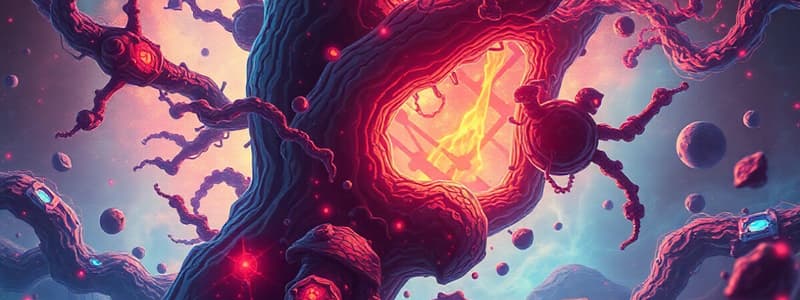Podcast
Questions and Answers
Which compounds are most likely candidates for enzymatic metabolic reactions?
Which compounds are most likely candidates for enzymatic metabolic reactions?
- Nonpolar hydrophilic compounds
- Polar hydrophilic compounds
- Nonpolar lipophilic compounds (correct)
- Polar lipophilic compounds
What are the two essential components provided by metabolism for any organism?
What are the two essential components provided by metabolism for any organism?
- Energy and Raw materials (correct)
- Energy and Water
- Proteins and Fats
- Raw materials and Hormones
What are the primary organs associated with xenobiotic metabolism?
What are the primary organs associated with xenobiotic metabolism?
- Heart and lungs
- Skin and kidneys
- Liver and gastrointestinal tract (correct)
- Stomach and bladder
What role does the liver play in metabolism?
What role does the liver play in metabolism?
What do phase I reactions primarily introduce to lipophilic toxicant molecules?
What do phase I reactions primarily introduce to lipophilic toxicant molecules?
How are volatile toxic substances typically eliminated from the body?
How are volatile toxic substances typically eliminated from the body?
How do xenobiotic compounds change through biotransformation?
How do xenobiotic compounds change through biotransformation?
Why are compounds with a high degree of polarity less likely to be metabolized in the body?
Why are compounds with a high degree of polarity less likely to be metabolized in the body?
Which compounds tend to bio-accumulate in lipid tissue due to resistance to enzymatic attack?
Which compounds tend to bio-accumulate in lipid tissue due to resistance to enzymatic attack?
Which pathway is a major route for environmental and occupational exposure to xenobiotics?
Which pathway is a major route for environmental and occupational exposure to xenobiotics?
Which of the following describes catabolic reactions in metabolism?
Which of the following describes catabolic reactions in metabolism?
What is a major mode of toxic action related to metabolism?
What is a major mode of toxic action related to metabolism?
In which form are lipophilic toxicants typically transported through the body before undergoing metabolism?
In which form are lipophilic toxicants typically transported through the body before undergoing metabolism?
What is a key function of the liver in relation to xenobiotic substances?
What is a key function of the liver in relation to xenobiotic substances?
What is meant by enzymatic metabolism in the context of xenobiotics?
What is meant by enzymatic metabolism in the context of xenobiotics?
What happens to many toxic substances due to metabolic processes?
What happens to many toxic substances due to metabolic processes?
What is the main purpose of a phase I reaction in the metabolism of xenobiotics?
What is the main purpose of a phase I reaction in the metabolism of xenobiotics?
Which type of reactions are most important in phase I metabolism?
Which type of reactions are most important in phase I metabolism?
How does urine pH affect drug reabsorption in the distal convoluted tubule?
How does urine pH affect drug reabsorption in the distal convoluted tubule?
What happens to the metabolites produced in phase II reactions?
What happens to the metabolites produced in phase II reactions?
Which of the following is an example of a drug that undergoes tubular secretion?
Which of the following is an example of a drug that undergoes tubular secretion?
What is the effect of urine alkalinization with Na Bicarbonate in aspirin overdose treatment?
What is the effect of urine alkalinization with Na Bicarbonate in aspirin overdose treatment?
What role do the organic anionic & cationic transporters (OAT & OCT) play in drug elimination?
What role do the organic anionic & cationic transporters (OAT & OCT) play in drug elimination?
The modifications made during phase I reactions primarily involve which of the following?
The modifications made during phase I reactions primarily involve which of the following?
Flashcards
Metabolism
Metabolism
The biochemical process by which substances are broken down and built up within a living organism.
Catabolism
Catabolism
Chemical reactions that breakdown larger molecules into smaller ones, releasing energy.
Anabolism
Anabolism
Chemical reactions that build larger molecules from smaller ones, requiring energy.
Biotransformation
Biotransformation
Signup and view all the flashcards
Non-Enzymatic Transformations
Non-Enzymatic Transformations
Signup and view all the flashcards
Polarity
Polarity
Signup and view all the flashcards
Enzymes
Enzymes
Signup and view all the flashcards
Liver
Liver
Signup and view all the flashcards
Volatile compounds
Volatile compounds
Signup and view all the flashcards
Nonpolar lipophilic compounds
Nonpolar lipophilic compounds
Signup and view all the flashcards
Compounds resistant to enzymatic attack
Compounds resistant to enzymatic attack
Signup and view all the flashcards
Xenobiotic metabolism sites
Xenobiotic metabolism sites
Signup and view all the flashcards
Phase I reactions
Phase I reactions
Signup and view all the flashcards
Phase II reactions
Phase II reactions
Signup and view all the flashcards
Unmodified lipophilic toxicants
Unmodified lipophilic toxicants
Signup and view all the flashcards
Urinary pH Trapping
Urinary pH Trapping
Signup and view all the flashcards
Tubular Secretion
Tubular Secretion
Signup and view all the flashcards
OAT & OCT
OAT & OCT
Signup and view all the flashcards
Half-Life
Half-Life
Signup and view all the flashcards
Inhibitor
Inhibitor
Signup and view all the flashcards
Study Notes
Chemistry of Toxicology - Lecture 2
- Toxicology studies the adverse effects of chemicals on living organisms
- Xenobiotics are substances foreign to an organism
- Xenobiotics are broken down through a process called metabolism
- Metabolism describes the biochemical changes that substances undergo in the body
- Metabolism changes a substance into various metabolites and some may be more toxic than the original compound
- Metabolites are excreted by various pathways
- Metabolism is critical for toxic action
- Some chemicals can cause toxic effects when metabolized
- Excretion removes these harmful compounds/metabolites from the body
- Excretion occurs through various parts of the body
-
Kidney -
Liver -
Lungs -
Sweat -
Saliva -
Tears
Pathways of Xenobiotic Species
- Xenobiotics are first metabolized before they can cause toxicity
- Substances are either detoxified or metabolized to a more toxic form
- Unchanged compounds can also be excreted
- Active metabolites can undergo further biochemical interaction
Metabolism
- The biochemical changes substances undergo in a living organism are called metabolism
- Metabolism breaks down chemical species
- Metabolism builds up new molecules, requiring energy for this process
- Metabolism provides two essential components: energy and raw materials
- Metabolism is important for toxicological chemistry
- Toxic effects can arise from interference with metabolism
- Toxicants can be transformed into less toxic forms, allowing for easier elimination from the body
Metabolism - Pathways
- Nutrients and xenobiotics enter the gastrointestinal tract
- Substances are broken down and transported into the bloodstream
- Most substances are transported through the intestinal walls to liver
- Liver metabolizes chemicals and plays a critical role
- Oxygen enters the bloodstream through the lungs
Biotransformation
- Biotransformation alters xenobiotic compounds, primarily through enzyme action
- Enzymatic and non-enzymatic reactions are involved
- Non-enzymatic reactions can cause bond formation with endogenous compounds, hydrolysis, or oxidation/reduction processes.
- The likelihood for biotransformation depends on the chemical nature of the xenobiotic
- Compounds with high polarity may be less absorbed and quickly excreted
- Those compounds resistant to enzymatic attack accumulate in lipid tissue
Biotransformation - Processes affecting
- Volatile compounds (e.g., dichloromethane, diethyl ether) are rapidly excreted by the respiratory system, so enzymatic metabolism is relatively less important for them
- Lipophilic compounds are more likely to accumulate in lipid tissues
- Xenobiotic metabolism can occur in various tissues throughout the body
- Key sites for metabolism include skin and lungs
- Liver is vital; materials entering the bloodstream from the digestive system pass through the liver first
Major Sites of Exposure, Metabolism and Storage and Elimination
- Major pathways for entry include ingestion, inhalation, and dermal exposure
- Chemicals in the gastrointestinal tract are processed before entering the bloodstream
- Processed compounds are transported to the liver for further metabolism
- Oxygen enters the bloodstream through the lungs
- Some substances are excreted by the kidneys
- Substances in the urine leave the body through the bladder
- Liver expels substances into bile, and they are excreted through the feces
- Exhalation removes carbon dioxide
Metabolism - Important Pathways for Excretion
- Volatile substances often enter the blood through the lungs
- Undigested food residues and liver waste leave the body in feces
- Urine produced by the kidneys and bladder eliminates metabolic waste products
- Waste carbon dioxide is eliminated through the lungs
Metabolism
- The process where a chemical (parent compound) is changed
- The chemical becomes more water soluble allowing easier excretion from the body
- Decreasing lipid solubility decreases amount of substance at target sites
- Increasing ionization rate increases excretion rate
Bioactivation
- Certain chemicals become more toxic through metabolic processes
- Substances can be transformed into compounds that are equally or more toxic than the original compound
Reactions of Metabolism
- Two primary phases (I and II) are involved in metabolic processes
- Phase I reactions introduce reactive, polar functional groups into initially lipophilic, nonpolar compounds (making them more polar/water soluble)
- Phase II reactions couple the compounds to soluble endogenous molecules making them more readily excreted
Phase I and Phase II Reactions (continued)
- Phase I reactions change the chemical structure of a xenobiotic by oxidizing, reducing or hydrolyzing it, making it more water-soluble
- The substance usually forms a more water-soluble compound
- Phase II reactions chemically conjugate the compound with water soluble molecules (more easily excreted)
- This makes the original substance more easily excreted from the body
Oxidation, Reduction, Hydrolysis
- Oxidation, reduction, and hydrolysis are frequently used in phase I reactions
- Oxidation of carbon, nitrogen, sulfur and phosphorus are commonly seen
Excretion
- Kidneys are the main excretory organ for various toxins, and carry out glomerular filtration and tubular secretion.
- The liver can also excrete substances via biliary excretion.
- Lungs excrete volatile compounds
Urinary pH Trapping
- Urinary pH affects excretion of drugs
- Changing the urine's acidity or alkalinity can alter the absorption of some drugs
Tubular Secretion
- Kidney's proximal renal tubules use transporters to actively secrete anionic and cationic drugs
- Certain drugs (e.g. penicillin) may be actively secreted into the filtrate
- Other compounds may compete for the same transporters, influencing the rates of excretion
Biliary Excretion
- Toxicants can be secreted into bile by the liver
- Bile carries substances to the small intestine where they are excreted in the stool
- Liver damage can reduce biliary excretion leading to an accumulation of toxic substances
Toxicodynamics
-
Effects of a chemical on the body, depending on its concentration at the target site
-
Certain organs are more susceptible than others, based on blood flow and metabolic reactions
-
Target organs include liver, kidneys, lungs, and neurons.
-
Adverse reactions are dependent on the concentration of a chemical at target sites and duration of exposure.
-
Modification of Carriers: toxins/chemicals can change the structure or function of carriers within cells; e.g., hemoglobin and carbon monoxide.
-
Interference with Coenzymes: toxins/chemicals can inhibit/destroy coenzymes, critical for a number of metabolic reactions
-
Formation of Reactive Metabolites: some substances become toxic when converted to reactive metabolites.
-
Reactions depleting GSH: loss of this antioxidant can lead to greater cellular damage.
-
Action on Nucleic Acids: toxins/chemicals can damage DNA and RNA, interfering with protein synthesis.
-
Alteration of protein synthesis: some chemicals interfere with protein production, disrupting cellular processes
-
Immunotoxicity: repeated exposure to a chemical can trigger an immune response.
Studying That Suits You
Use AI to generate personalized quizzes and flashcards to suit your learning preferences.



